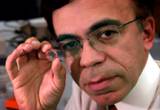| Oncology | |||
Implantable wireless device for measuring radiation dose in tumours19 April 2006 West Lafayette, Ind. USA. Engineers at Purdue University are creating a wireless device the size of a rice grain that could be implanted in tumours to tell doctors the precise dose of radiation received and locate the exact position of tumours during treatment.
Researchers at Purdue's Birck Nanotechnology Center have tested a dime-size prototype to prove the concept and expect to have the miniature version completed by the end of summer, said Babak Ziaie (pronounced Zee-Eye-Eee), an associate professor in the School of Electrical and Computer Engineering. "Currently, there is no way of knowing the exact dose of radiation received by a tumour," Ziaie said. "And, because most organs shift inside the body depending on whether a patient is sitting or lying down, for example, the tumour also shifts. This technology will allow doctors to pinpoint the exact position of the tumour to more effectively administer radiation treatments." The device is a passive wireless transponder, which has no batteries andis activated with electrical coils placed next to the body. "It will be like a capsule placed into the tumour with a needle," said Ziaie, who has a dual appointment in Purdue's Weldon School of Biomedical Engineering. Although imaging systems now used can provide a three-dimensional fix on a tumour's shifting position during therapy, these methods are not easy to use during radiation therapy, are costly and sometimes require X-rays, which can damage tissue when used repeatedly, he said. Doctors could use the wireless technology, however, to precisely track a tumour by using three or six coils placed around the body to pinpoint the location of the electronic device, Ziaie said. Researchers tested the prototype with a radioactive caesium. The device, which contains a miniature version of dosimeters worn by people in occupations involving radioactivity, could provide up-to-date information about the cumulative dose a tumour is receiving over time. The technology uses the same principle as electret microphones, popular products found in consumer electronics stores. The microphones contain a membrane that vibrates in response to sound waves. Between the membrane and a metal plate is an air gap that serves as a capacitor, or a device that stores electricity. As the membrane vibrates, the size of the air gap changes slightly, increasing and decreasing the capacitance and altering the flow of electric current through the circuit, creating a signal that transmits information stored in the dosimeter. "It's basically like a very small tuning circuit in your radio," Ziaie said. "This will be a radiation dosimeter plus a tracking device in the same capsule. It will be hermetically sealed so that it will not have to be removed from the body." The device is an example of a microelectromechanical system, or a tiny mechanical device fabricated using methods generally associated with microelectronics. The Purdue engineers have begun working with researchers at the Indiana University School of Medicine to further develop the technology. The research has been funded by the National Science Foundation. Research findings were published in the proceedings of the 19th IEEE International Conference on Micro Electro Mechanical Systems, a conference organized by the Institute of Electrical and Electronics Engineers.
|
